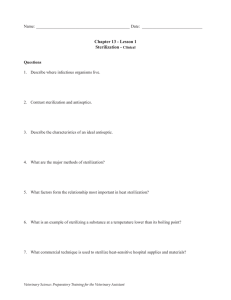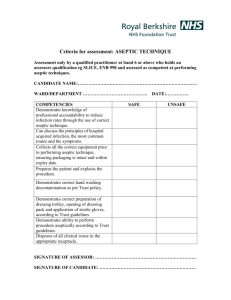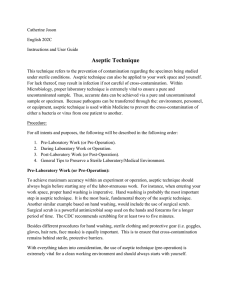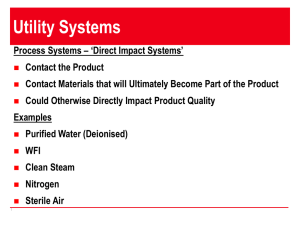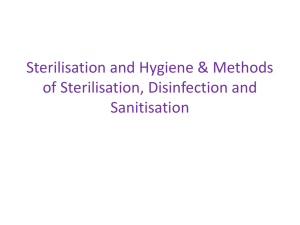Terminal Sterilization vs. Aseptic Processing
advertisement
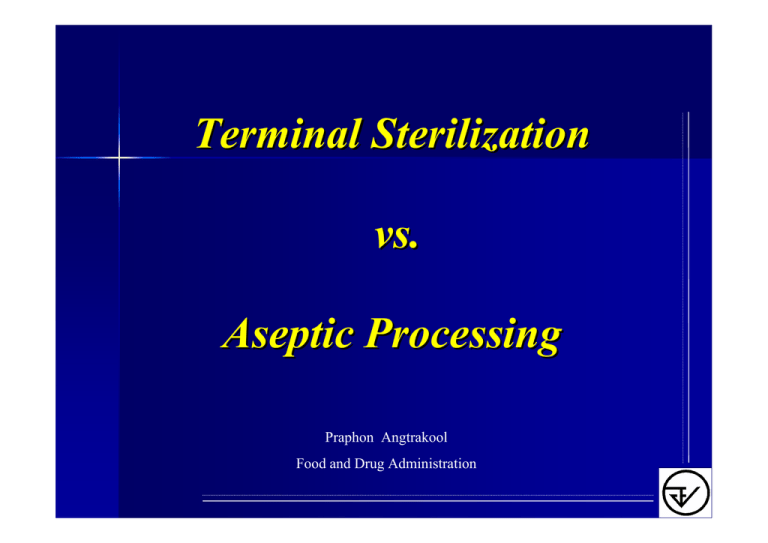
Terminal Sterilization vs. Aseptic Processing Praphon Angtrakool Food and Drug Administration 1 Sterile Drug Products Produced by Aseptic Processing It is a well-accepted principle that sterile drugs should be manufactured using aseptic processing only when terminal sterilization is not feasible. However, some final packaging may afford some unique and substantial advantage (e.g., some dual-chamber syringes) that would not be possible if terminal sterilization were employed. In such cases, a manufacturer can explore the option of adding adjunct processing steps to increase the level of sterility assurance. 2 From ; Guidance for Industry Sterile Drug Products Produced by Aseptic Processing; US FDA (2004) Product requirements FDA has stated, where possible, that the use of terminal sterilization should be used in the manufacture of sterile product Where this is not feasible without detriment to the product, an alternative means of achieving the end objective must be demonstrated Consequently, the first step in establishing the processing conditions, and therefore the design of the manufacturing facility, is to determine whether terminal sterilization will be required. In some cases an additional method e.g. heat treatment, can be added to aseptic processing to better assure product safety 3 From : ISPE Guide, Volume 3 Sterile Manufacturing Facilities, First Edition. 1999 PDA Technical Report #36 : Current Practices in the Validation of Aseptic Processing - 2001 At your site, is aseptic processing used for products that could be terminally sterilized? For this response, “could be terminally sterilized” means capable of withstanding a steam sterilization cycle with FO > 8 minutes. 4 At your site, is aseptic processing used for products that could be terminally sterilized? No 67.4% 85% Yes 32.6% 30% (mean) 2% n = 43 If Yes, then percentage of products affected Source : PDA Technical Report #36: Current Practices in the Validation of Aseptic Processing - 2001 5 Recalls Lack of Sterility Assurance 60 50 40 Number 30 of Recalls 20 10 0 '88 '90 '92 '94 '96 '98 '00 '02 Fiscal Year ¾ Lack of Sterility Assurance is the #1 reason for drug recalls in last 5 years ¾ Nearly all drugs recalled due to Lack of Sterility Assurance in last 20 years were produced via aseptic processing 6 Global Scene European Agency for the Evaluation of Medicinal Products (EMEA) Terminal Sterilization Fo > 15 minutes “Adjunct” Processing Fo > 8 minutes, and PNSU > 1 in 106 Aseptic Processing From: Decision Trees for the Selection of Sterilization Methods (10/1999) 7 Global Scene European Agency for the Evaluation of Medicinal Products (EMEA) “ Where a choice is made not to utilise a method of terminal sterilization, … proper scientific explanation and justification should be provided in the dossier.” “ Heat lability of a packaging material should not in itself be considered as adequate justification for not utilising terminal sterilisation, for otherwise heat stable products.” From: EMEA Note for Guidance on Development Pharmaceutics (July, 1998) 8 Questions Should terminal sterilization be used when feasible? Should adjunct processing be considered in order to increase confidence in aseptically processed products? 9 Decision tree for selection of the sterilisation methods European Medicines Agency 10 Decision tree for selection of the sterilisation methods (1) Those products intended to be sterile should be terminally sterilised in their final container as clearly stated in the European Pharmacopoeia, and in the CPMP Notes for Guidance. Where it is not possible to carry out terminal sterilisation by heat due to formulation instability, a decision should be taken to utilise an alternative method of terminal sterilisation, filtration and/or aseptic processing. It is recognised that new terminal sterilisation process other than those described in the pharmacopoeia may be developed to provide sterility assurance levels equivalent to present official methods, and such processes when properly validated may offer 11 alternative approaches. Decision tree for selection of the sterilisation methods (2) When moving down the decision tree it is clear that these methods generally show decreasing level of sterility assurance, and it is therefore essential for product quality and safety to ensure that the highest level of sterility assurance is achieved in conjunction with the lowest level of pre-sterilisation bioburden appropriate. These decision tree are intended to assist in the selection of the optimal sterilisation method taking into account the various complicating factors. (A similar approach should be considered in the selection of sterilisation methods for intermediates to be 12 incorporated into the finished product using aseptic processing) Decision tree for selection of the sterilisation methods (3) The use of an inappropriate heat-labile packaging material cannot in itself be the sole reason for adoption of aseptic processing. Rather manufacturers should choose the best sterilisation method achievable for a given formulation and select the packaging material accordingly. However, it may be that the choice of a packaging material for a given product has to take into account factors other than the method of sterilisation. In such cases these other factors need to be clearly documented, explained and scientifically justified in the MA dossier. 13 Decision tree for selection of the sterilisation methods (4) Conventionally, it has been accepted that other factors such as the type of container, route of administration and patient benefit have contributed to the choice of a particular container type, which will not withstand terminal heat sterilisation (e.g. certain ophthalmic products) and such products are therefore manufactured by validated aseptic processing. In such cases manufacturers have a duty to continue the search for acceptable alternative containers which would allow the move to the preferred terminal sterilisation in an acceptable timeframe. Commercial considerations should not be used as justification for not using terminal sterilisation with the highest possible level14 of sterility assurance Decision tree for the sterilisation choices for aqueous products Can the product be sterilised by moist o heat at 121 C for 15 minutes ? YES NO Can the product be sterilised by moist heat Use autoclaving at at Fo ≥ 8 minutes achieving SAL of ≤10 -6 121 oC for 15 NO YES Can the formulation be filtered Use moist heat with Fo ≥ 8 minutes through a microbial retentive filter NO minutes YES Use pre-sterilised individual components Use a combination of aseptic and aseptic compounding and filling filtration and aseptic processing 15 Decision tree for sterilisation choices for non-aqueous liquid, semi-solid or dry powder products Can the product be sterilised by dry heat at 160 oC for 120 minutes NO YES Can the product be sterilised by dry heat with an alternative combination of time and temperature to the standard cycle achieving SAL of ≤10 -6 ? Use sterilisation at 160 oC for 120 minutes YES NO Can the product be sterilised by method different from dry heat e.g. ionising radiation with an absorbed minimum dose of ≥ 25 KGy ? YES Use dry heat with alternative combination of time and temperature to the standard cycle achieving SAL of ≤10 -6 NO Can the product be sterilised by using a validated lower irradiation dose (ref. ISO 11137) NO Can the formulation be filtered through a microbial retentive filter NO Use pre-sterilised individual components and aseptic compounding and filling YES YES Use sterilisation with an absorbed minimum dose of ≥ 25 KGy ? Use sterilisation by validated irradiation dose. Use filtration and aseptic processing 16 Process Validation : Moist Heat Sterilization for Pharmaceuticals Health Canada Health Product and Food Branch 17 1. Introduction (1) The Health Products and Food Branch Inspectorate (HPFBI) of Health Canada recognizes that terminal moist heat sterilization, when practical, is presently considered the method of choice to ensure sterility. For the purpose of ensuring sterility, all aqueous-based sterile products are subject to terminal moist heat sterilization, with the following exceptions : Instances where terminal moist heat sterilization is not practical, e.g., product degradation. Such instances are fully evaluated and documented. And for aseptic processes that exclude human intervention e.g., robotics, form-fill-seal and barrier system, may be employed in lieu of terminal moist heat sterilization providing 18 that validation data demonstrated equivalence. 9. Sterilisation cycle development (1) Two basic approaches are employed to develop sterilization cycles for moist heat processes : Overkill Probability of Survival. The "F" and "D" terms used below to describe these methods are defined in Section 10. 19 9. Sterilisation cycle development (2) 9.1 The Overkill method The Overkill method is used when the product can withstand excessive heat treatment such as an Fo ≥ 12 without adverse effects. effects Bioburden and resistance data are not required to determine the required "Fo" values. Cycle parameters are adjusted to assure that the coldest point within the load receives an "Fo" that will provide at least a 12-log reduction of microorganisms having a "D121" value of at least one minute (i.e.: Fo ≥ 12) 20 9. Sterilisation cycle development (3) 9.2 The Probability of Survival The Probability of Survival approach is used primarily for heat labile products. In this approach, the process for the terminal sterilization of a sealed container is validated to achieve the 0 destruction of pre-sterilization bioburden to a level of 100, with a minimum safety factor of an additional six-log reduction (1x10-6). The probability that any one unit is contaminated is therefore no more than one in a million; this is considered to be an acceptable level of sterility assurance. 21 9. Sterilisation cycle development (4) a) The probability of survival is determined using a semi-logarithmic microbial death curve, where a plot of the log of the number of survivors versus time at a fixed temperature yields a straight line. 0 After the line has crossed below 10 (less than one survivor), the y-value corresponding to a given time value is expressed as the probability of survival. b) The determination of the minimum "Fo" value for the Probability of Survival approach is based upon the number of microorganisms (bioburden) found in a given product and their heat resistance. c) Methods for conducting bioburden studies, estimating microbial heat resistance and determining the minimum required "Fo" value 22 for sterilization. Pharmacopoeia EU 2005 Steam sterilization of terminal sterilization the reference condition for aqueous preparations are heating at a minimum of 121 oC for 15 minutes Sterility Assurance Level (SAL) 10-6 or better USP 29 Terminally sterilized products(TSP) must have a probablity of nonsterility (PNS) of not more than one in a million units produced. This is often stated as a PNS of 10-6 or the probablity of product bioburden surviving the sterilization process in any single unit of product is 23 less than one in one million. Reference Decision Trees for the Selection of Sterilization Methods (10/1999) , The European Agency for the Evaluation of Medicinal Products (EMEA) Guide Process Validation : Moist Heat Sterilization for Pharmaceuticals, Health Products and Food Branch Inspectorate, Date of implementation : May 1, 2001 Guidance for Industry Sterile Drug Products Produced by Aseptic Processing, U.S. FDA, 2004 Pharmaceutical Engineering Guides for New Renovated Facilities, Volume 3 Sterile Manufacturing Facilities, First Edition. International Society for Pharmaceutical Engineering, 1999 24
